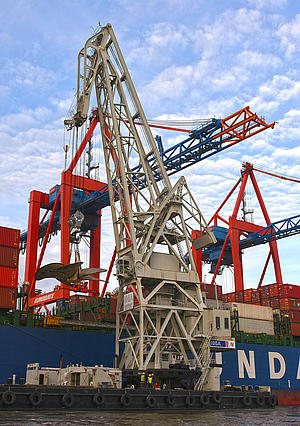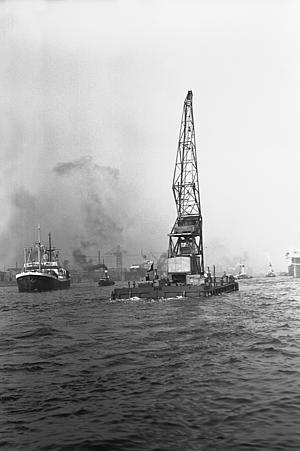Quicklinks
Quicklinks
The cranes look brand new – on the outside, at least. This is hardly surprising, considering the amount of care, attention and affection that goes into maintaining them. It's only when you go inside that their real age is betrayed by the metal signs in the gangways, which have been repainted a number of times.

HHLA III was built for the Germany navy in 1941 and was used by the Hamburg shipyards to construct warships and then to rebuild the decimated docks after the war. The volume and sizes of goods being processed in the docks soon began to increase again. So as the only floating crane capable of lifting loads of 100 tons, HHLA III really had its work cut out. Hamburg's electricity and port authority therefore commissioned the construction of a new floating crane with a hoisting capacity of 200 tons in 1957, which is today's HHLA IV crane.
They both now bear the HHLA name having been acquired by the company in the 1960s. These floating cranes operate as articulated luffing cranes with unlimited slewing. Their sturdy frames allow loads to be transported horizontally. The taller of the two cranes, HHLA III, can lift a 'mere' 100 tons, but hoists its loads to up to 48 metres thanks to its impressive overall height of 76 metres. And as the younger of the two, it is down to HHLA IV to lift the heavier goods in the docks. This slightly more compact giant can lift loads of up to 200 tons and weighs 2,750 tons itself. But even with this weight and a full load, the crane's rectangular pontoon can still be steered with millimetre precision. There are vertically adjustable blades below the propellers of the portside and starboard engines that are able to make fractional course corrections with minimum propulsion.

Until into the 1980s, HHLA's fleet of floating cranes also included two 30-ton cranes, HHLA I and HHLA II. These two cranes were constructed in 1928 by two Hamburg-based global enterprises that no longer exist: Deutsche Werft and the crane manufacturer Kampnagel. HHLA I was endowed to the historical harbour at Övelgönne in Hamburg in 1986, where it can still be visited today. Before being decommissioned, it racked up more than 100,000 working hours as the oldest active crane in the Port of Hamburg at that time. Until recently, there was little more to see than the shrouded silhouette of the crane as painstaking restoration work was under way.
At the turn of the year 2011, HHLA III was covered up for a number of months. The crane's jib, which was taller than much of the equipment used in the port, had been dismantled, and the rest of the crane was sandblasted and repainted. New parts, the heaviest of which weighed 65 tons, were shipped in from Poland. The new strut and tie members, jib head and swing arm were unloaded with the aid of HHLA IV. This heavy-duty puzzle then had to be put back together on dry land with the help of mobile cranes, including all of its pulleys, bearings, climbing systems and steel cables, each of which is four centimetres thick and 500 metres long.
In February 2012, this 71-year-old grande dame then lifted a load of 110 tons – that's 10 tons more than the usual maximum load – without any difficulty, as observed by examiners from Germanischer Lloyd and from the employers' liability insurance association. The crane still complies with all the applicable safety requirements, with Germanischer Lloyd having monitored every step of the repair process and examined all of its weld joints and wiring.
The HHLA IV floating crane was operating for almost 60 years with its two MAN engines, for which there are no longer any more spare parts. They have been replaced using a complex process with new high-performance engines from the Anglo Belgian Corporation (ABC).
The only similar cranes still in operation are in the Panama Canal and at the Long Beach shipyard. They are still very efficient, despite their age, and usually moored alongside container mega-ships in order to offload cargo which is too heavy for the container gantry cranes. Huge ship propellers are one of the most common heavy-duty cargoes.
There is a lot of space available for their storage, because the floating cranes have been allocated right by the HHLA Container Terminal Tollerort at the Hachmannkai quay. The location is close to perfect, directly opposite Blohm + Voss and MAN. Both companies are customers. Although ever-larger ships and increasing hoisting capacity requirements are making ever-increasing demands on the fleet of cranes, HHLA is not about to let these friendly giants simply rust away.